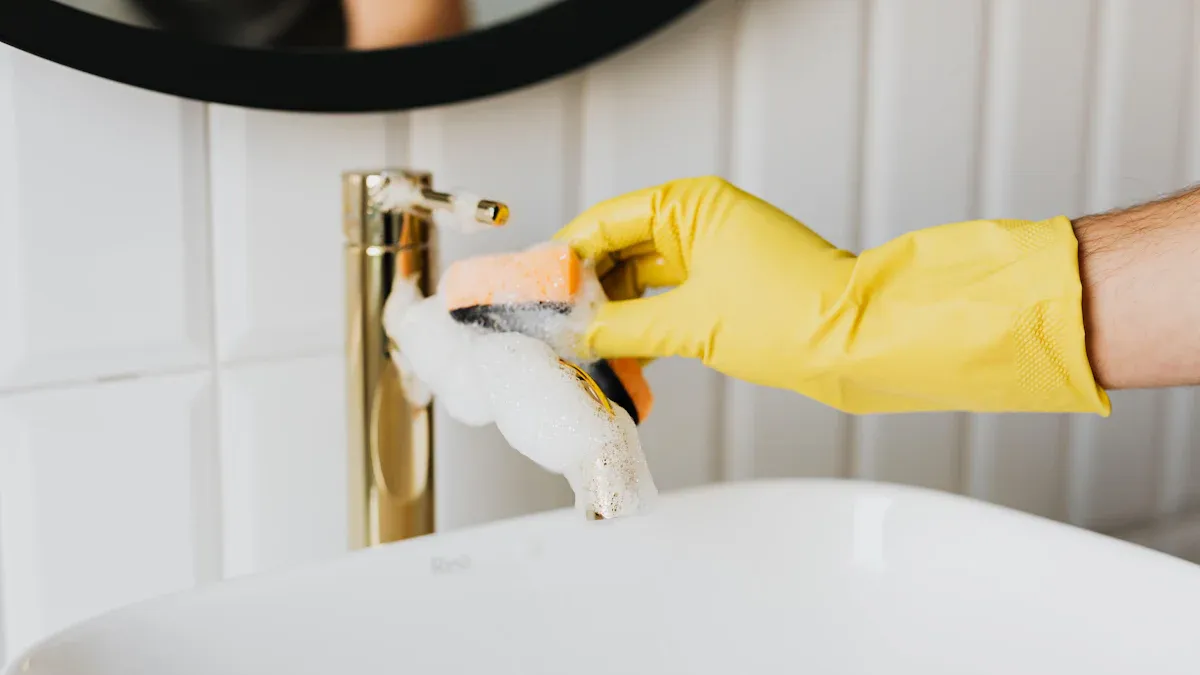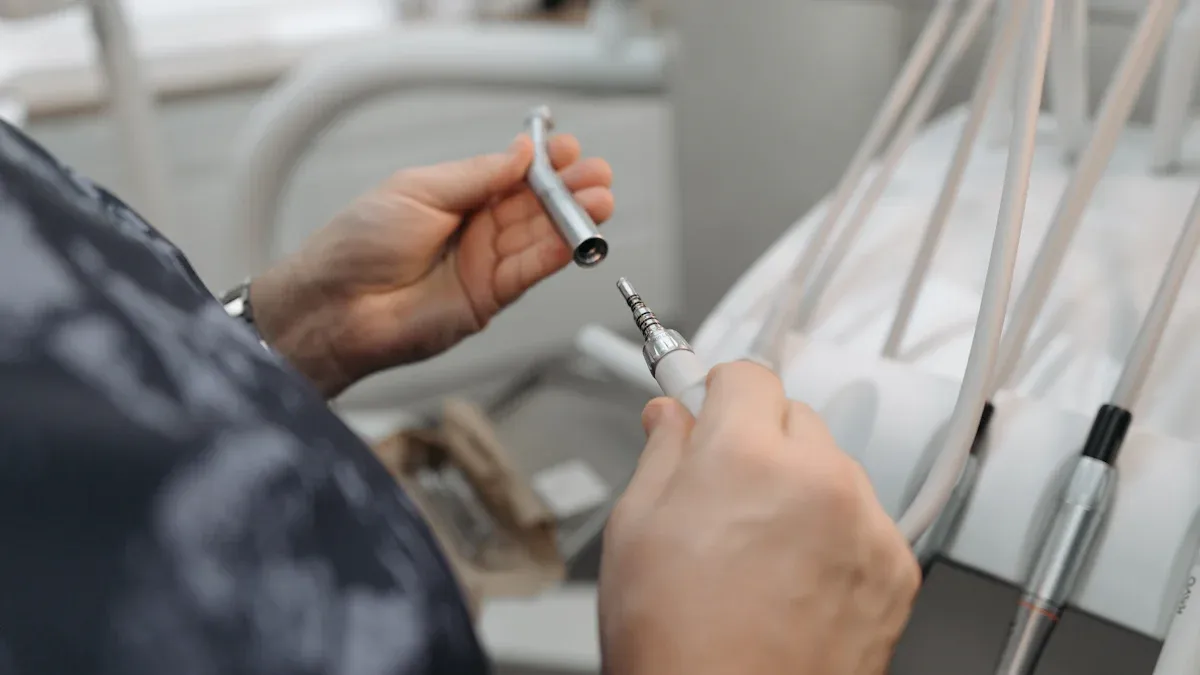
 FEEDBACK
FEEDBACK
If you are interested in our products and want to know more details, please leave a message here, we will reply you as soon as possible.


You want your stainless steel vanity to look clean and shiny. But sometimes, things get messy. You might see water spots or tough stains. Sometimes, a rough sponge can leave a scratch. These problems can make cleaning seem hard. The good news is you can keep your Clean Vanity looking great. Use safe products and a simple routine. Always use gentle tools and dry it quickly. This helps stop rust, mineral buildup, and damage to the surface.
Start by clearing everything off your vanity. Take away soap, toothbrushes, and any bottles or baskets. This gives you a clear space to work and helps you spot any hidden messes. Wipe away loose dust or hair with a dry microfiber cloth. If you see any sticky spots, use a damp cloth to gently lift them. Removing clutter makes it much easier to Clean Vanity surfaces and reach every corner.
Tip: Always check for small items that might roll away or get lost during cleaning.
Choose cleaning products that are gentle and safe for stainless steel. You want to avoid anything with bleach, ammonia, or harsh chemicals. These can damage the finish and even cause health problems over time. Instead, reach for mild dish soap, baking soda, or a mix of vinegar and water. Plant-based cleaners work well and are better for the environment. Some people like to use a special stainless steel cleaner, but make sure it is free from strong chemicals. Using safe products helps your Clean Vanity stay shiny and protects your family and pets.
Here’s a quick list of what works best:
Mild dish soap and warm water
Baking soda for tough spots
Vinegar and water mix for natural cleaning
Plant-based stainless steel cleaners
Microfiber cloths are your best friend when cleaning a stainless steel vanity. They pick up dust and grime without scratching the surface. Always wipe with the grain of the metal. This keeps the finish looking smooth and prevents streaks. After cleaning, use a dry microfiber cloth to buff the surface. This step helps prevent water spots and leaves your vanity sparkling.
Note: Never use steel wool or rough sponges. These can scratch and dull your vanity.
You want your Clean Vanity to look spotless every day. A simple routine keeps it fresh and prevents stains from building up. Here’s how you can do it:
Grab a soft microfiber cloth and dampen it with warm water.
Add a drop of mild dish soap or a gentle cleaner like Bar Keepers Friend to the cloth.
Wipe the stainless steel surface, moving in the direction of the grain. This helps avoid streaks and keeps the finish smooth.
Rinse the cloth with clean, hot water and wipe the surface again to remove any soap or cleaner.
Dry the area right away with a fresh towel or microfiber cloth. This step stops water spots and keeps your Clean Vanity shiny.
Tip: Never use steel wool, rough sponges, or harsh chemicals. These can scratch or dull your vanity. Always remove items like wet towels or sponges from the surface to prevent bacteria and stains.
Sometimes, your vanity needs a little extra care. Deep cleaning helps remove stubborn stains, heat marks, or discoloration. You can do this once a week or whenever you notice tough spots.
Mix a small amount of baking soda with water to make a gentle paste. Spread it on any stains or marks.
For hard water spots or mineral buildup, use diluted vinegar. Spray it on the stain and wipe with a soft cloth, always following the grain.
If you see rust or heat discoloration, try a stainless steel brightener like affresh®. These products are made for tough jobs.
Homemade cleaners work well too. You can mix dish soap with warm water, or combine vinegar and a few drops of mineral oil for extra shine.
Always avoid bleach, ammonia, glass cleaners, or abrasive pads. These can damage the surface and leave scratches.
Note: Always clean and buff in the direction of the grain. This keeps your vanity looking smooth and prevents streaks.
Drying is just as important as cleaning. If you let water sit, it can leave spots or even cause corrosion over time. Here’s how to keep your vanity dry and shiny:
After cleaning, use a dry microfiber cloth to wipe the surface. Move in an S-pattern and follow the grain.
Never let water air dry on the vanity. This can cause mineral spots and streaks.
For extra shine, put a few drops of light or regular olive oil on a clean cloth. Wipe the surface gently, again following the grain.
Buff with a dry cloth to remove any extra oil. This step makes your vanity gleam and helps prevent fingerprints and smudges.
Callout: Olive oil is safe, eco-friendly, and easy to find. It adds a protective layer that keeps your Clean Vanity looking new. Just remember to use a small amount so the surface does not get greasy.
If you live in a humid area, check the joints and edges often. Make sure water is not getting underneath the surface. Wipe up spills right away and reapply a protective coating if needed. This helps prevent warping, mold, and other damage.
Tip: Always spray cleaner on your cloth, not directly on the vanity. This gives you more control and avoids streaks.
You want your stainless steel vanity to stay smooth and flawless. Scratches can make it look old fast. Here’s how you can keep the surface safe:
Choose a vanity with a pre-brushed retro vintage finish. This type of surface resists scratches better.
Place PVC sink mats or liners on the bottom. These cushion the surface and stop sharp objects from leaving marks.
Use sink grids to protect the vanity from direct contact with metal tools or heavy items.
Try roller mats or foldmat protectors. These not only prevent scratches but also help with draining and organizing.
Always handle the surface gently. Avoid dropping metal objects or dragging items across the vanity.
Tip: Keep iron particles away from your vanity. Even small bits can scratch or stain the surface.
Stains can sneak up on you. They often come from leaving metal cans, wet sponges, or even certain soaps on the vanity. Rust stains may appear if you leave cast iron or metal pans soaking. Sometimes, harsh chemicals like toilet bowl cleaners can cause permanent marks.
You can remove most stains without damaging the surface. Try these safe cleaning agents:
Use an oxalic acid solution for rust stains. Apply it with a soft cloth, wait a few minutes, then rinse well.
For limescale, mix one part vinegar with three parts water. Scrub gently with a nylon brush.
Remove oil or grease with isopropyl alcohol or acetone on a soft cloth.
For heat stains, use a domestic metal polish and treat the whole area to keep the color even.
Always rinse with clean water and dry after cleaning.
Note: Never use steel wool, abrasive pads, or harsh chemicals. These can scratch or damage your vanity.
Water spots can make your vanity look dull. You can prevent them by drying the surface after every use. If you see spots, soak them with full-strength vinegar for 5–10 minutes. Rub gently, then rinse with a baking soda solution. Rinse again with clean water and dry with a soft cloth.
Clean with mild dish soap and dry right away to stop new spots from forming.
Apply a thin layer of olive oil or baby oil to create a water-repellent barrier.
For hard water, consider installing a water softener to reduce mineral buildup.
Callout: Avoid ammonia-based cleaners and rough sponges. They can damage the finish and make water spots worse.

You can keep your stainless steel vanity looking fresh with a few simple habits. Wipe down the surface after each use with a soft microfiber cloth. Use mild dish soap and warm water to remove dirt and prevent buildup. Dry the vanity right away to stop water spots and rust. Clean around the drain and fittings to keep everything hygienic. Always follow the grain when you wipe. This helps prevent scratches and keeps the finish smooth. Avoid steel wool or rough sponges. Use only gentle tools.
Tip: Small daily cleaning tasks make deep cleaning much easier later.
Once a week, give your Clean Vanity a deeper clean. This helps remove stains, mineral deposits, and any grime that daily care might miss.
Sprinkle baking soda over the surface.
Add a few drops of mild dish soap.
Gently scrub with a soft sponge, following the grain.
Spray white vinegar and let it sit for a few minutes to dissolve spots.
Rinse with warm water and dry with a microfiber cloth.
Buff with a little olive oil or baby oil for extra shine and protection.
You should also check for any cracks or discoloration in sealants once a year. Replace them if needed to keep your vanity in top shape.
A tidy vanity makes cleaning faster and keeps your bathroom looking great. Try these steps:
Schedule a decluttering session every few weeks. Remove expired or unused items.
Group similar products together, like skincare or hair care, for easy access.
Use trays, baskets, or wall-mounted shelves to keep items off the counter.
Store extras in labeled bins outside the bathroom.
Keep only daily essentials on the countertop.
Callout: Encourage everyone in your home to put things back in their place. This keeps your vanity organized and easy to clean.
You can keep your stainless steel vanity looking great for years. Just stick to a simple routine. Use gentle, pH-neutral cleaners and wipe with a microfiber cloth. Always clean along the grain and dry the surface right away. Avoid harsh chemicals and rough pads. Check for stains or scratches each week and fix them fast. Regular care helps your vanity stay shiny, strong, and easy to clean.
Remember, a little daily effort goes a long way. Your vanity will keep its modern look and last for decades.
You should wipe your vanity every day. Do a deep clean once a week. This keeps it shiny and stops stains or water spots from building up.
First, make a paste with baking soda and water. Rub it gently on the rust spot with a soft cloth. Rinse and dry the area. Repeat if needed.
Yes, you can use vinegar to remove water spots or mineral buildup. Spray it on a soft cloth, wipe the surface, then rinse and dry. Never let vinegar sit too long.
Use only microfiber cloths or soft sponges. Never use steel wool or rough pads. Place mats or trays on the vanity to protect the surface from sharp objects.